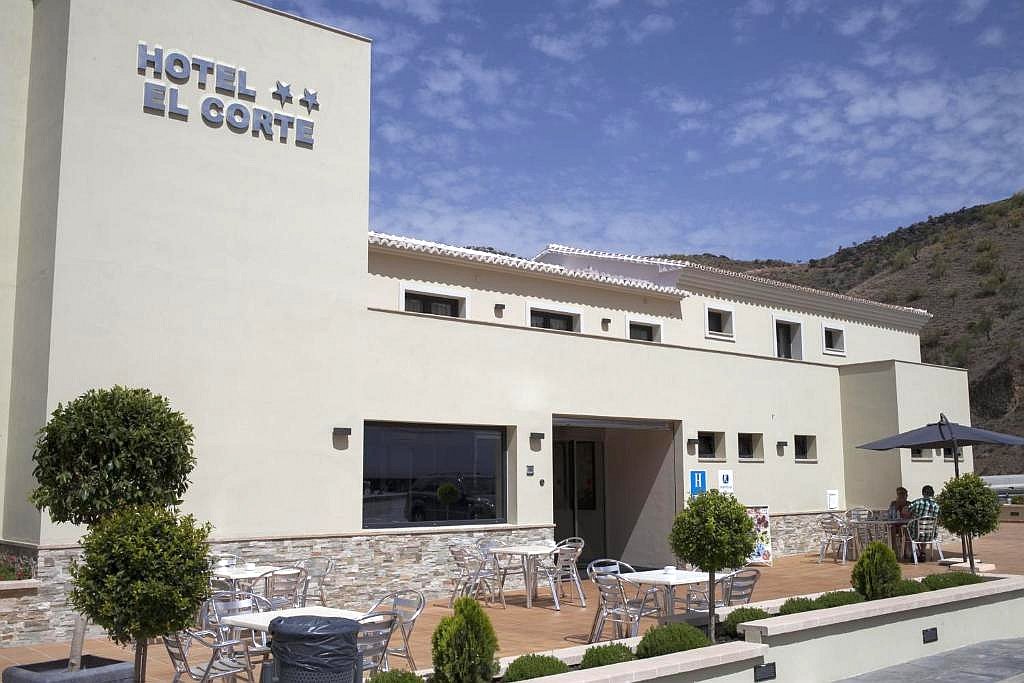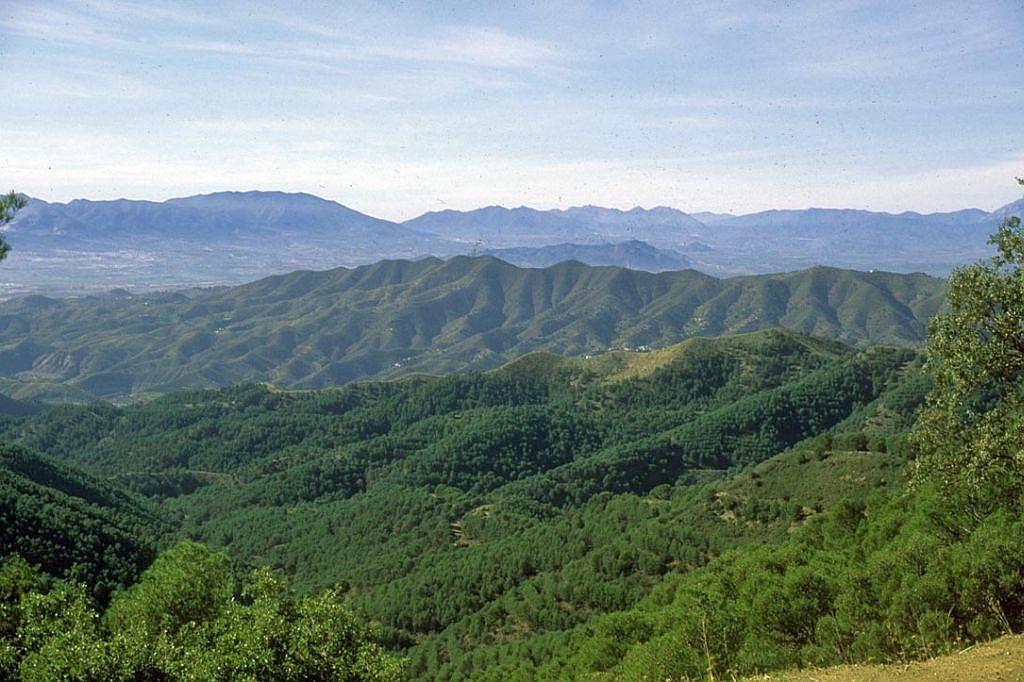- Region: Andalucia
- Province: Malaga
- Declared a Natural Park: 1989
- Park surface area: 4,996 hectares
- Towns in the Montes de Malaga Area: Casabermeja, Colmenar, Málaga
Points of interest
The Montes de Málaga natural park is just 5km from the city of Málaga. It consists of rolling hills and mountains with a high point of 1031m. The highest road pass is Puerto de León at 960m. There are many streams that cut through the park and fall into the Guadalmedina river to the west. The slopes are planted with pines and offer beautiful views of the Mediterranean countryside and coast.
The natural trees and scrub were removed to allow for cultivation as early as the 16thC. At this time olive trees and vines were planted but this caused a major problem in more recent past for the city of Málaga. Clearing the ground over the centuries had allowed water erosion, which silted up the river course and created flash flooding of the city below. This problem was eased around 1930 by the mass planting of Aleppo pines.
Many country restaurants or “Ventas” can be found through the park making it an extremely busy retreat from the city at weekends and bank holidays. (Read about ventas in the Ronda area here)
Activities from Get Your Guide
The area is a favorite for cycling, walking, hiking, and horse riding. For more ways to explore, check out guided experiences in the Montes de Málaga on Get Your Guide.

European Nature 2000 celebration day
Each year, May 21st, marks the celebration of one of the world’s largest networks of protected areas and the primary tool for conserving biodiversity in Europe. Andalusia boasts a significant representation in this catalog of natural spaces, encompassing a total of 2.67 million hectares, with Malaga ranking as the second province in our region with 39 spaces included.
Montes de Málaga became the latest addition to the European ecological network among Andalusian natural areas, receiving its designation as a Site of Community Importance (SCI) in 2018
Find a hotel in the Montes de Malaga
Although Malaga is near enough to base yourself for day trips to the Montes de Malaga, I have always stayed in the village of Casabermeja where there is a great selection of small hotels and rural accommodation.
My hotel of choice, though, is El Corte which also has a great restaurant. The hotel is located along the A-45 just 2 km from Casabermeja. Find out prices and availability over at Booking.com.

This video features a captivating selection of images from the annual Montes de Málaga photography contest.
Flora
In the northern area of the park natural vegetation of Carob (Ceratonia siliqua), Wild olives (Olea europaea subsp. oleaster), Holm (Quercus ilex), Cork (Quercus suber) and Gall oaks (Quercus faginea) occur. Otherwise Aleppo pines (Pinus halepensis) are planted to secure the land. Other pines found here are Stone pine (Pinus pinea) and Monterey pine from California.
Lower shrubs include Lentisc (Pistacia lentisc), Strawberry tree (arbutus unedo), Kermes oak (Quercus coccifera), Prickly juniper (Juniperus oxycedrus), Oleander (Nerium oleander), Myrtle (Myrtus communis), Dwarf fan palm (Chamaerops humilis), Rockrose (Cistus ladanifer), Rosemary (Rosmarinus officinalis), Spanish lavender (Lavandula stoechas) and Thyme (thymus vulgaris).
Fauna
The Chameleon (Chamaeleo chamaeleon) comes top of the list for animals in the park. There are very few areas of suitable habitat left in Iberia for this unusual lizard. Other reptiles are spine-footed lizards, ocellated lizards, salamanders and geckos.
Mammals include Wild boar, Fox, Badger, Polecat, Genet, Weasel, Stone martin, Wild cat, Squirrel, Hedgehog and Rabbit.
Birdlife includes Short-toed and Booted eagles, Goshawk, Buzzard, Eagle, Barn and Tawny owl. Some of the smaller birds are Cuckoo, Thrush, Redwing, Green woodpecker, Jay, Woodpigeon, Red legged partridge, and sometimes Ring Ouzels in winter. The Firecrest is often seen as are all Tits. Nightingales living by the waterways can be heard in summer.
Also in the area
- In the Piedras de Cabrera area there are cave paintings in small scattered caverns.
- Malaga city has historic buildings such as the Cathedral and ruins like the Roman amphitheatre and Arab fortress with city walls.
- In Casabermeja the only Moorish remains are walls and the Zambra Tower.
- Megalithic burial chambers have been found in the hills of Lagar de Villanueva and Chapera, as well as near the Cortijo del Hospital.
- Histórico La Concepción Botanical Gardens. A 23-hectare botanical garden dating to 1855, with tropical & subtropical flora from 5 continents. Website (in Spanish)
Other Activities and excursions in the Malaga area
Information/Visitors Centers
Ethnological museum “Lagar de Torrijos” On the road from Málaga to Colmenar (C-345) Km 544 (One kilometre past La Fuente de la Reina and about 20 kilometres from Malaga.)
The Lagar de Torrijos Ecomuseum stands in the midst of the dense pine groves so typical of the Montes de Malaga, at the beginning of one of the most attractive trails in the Nature Park.
The Montes de Malaga area was very famous in the past for its superb sweet, semi-sweet and dry wines. Even today the area conserves a number of the traditional wine pressing houses called lagares, although they are somewhat few and far between. Lagares are buildings in which most of the space is dedicated to wine production. One outstanding example is the Lagar de Torrijos, which dates back to 1843 and represents a prototypical Montes de Malaga wine pressing house. The building, which has been conserved virtually just as it was built, today houses an Ecomuseum which no visitor to the Nature Park can afford to miss.
The display inside provides a full explanation of the time honoured traditional techniques employed to produce the superb wines which have given the area such renown. Visitors can also browse through rooms containing bread ovens, an oil mill and even the living quarters.
Montes de Málaga Natural Park: Top Visitor Questions Answered
The Montes de Málaga Natural Park is just 5 km north of Málaga city. This makes it a popular escape for locals and visitors who want to enjoy nature without travelling far. Weekends and holidays often see the park filled with hikers, cyclists, and families enjoying traditional country restaurants called ventas. More details about the routes and activities can be found in the main article.
Walking, cycling, horse riding, and birdwatching are among the favourite activities here. Thanks to its varied terrain, the park suits both casual walkers and seasoned hikers. Guided tours are also available through platforms like Get Your Guide, offering unique ways to explore its landscapes and history.
Aleppo pines were planted extensively in the 1930s to reduce soil erosion and flooding in Málaga city. Earlier land clearing for vineyards and olives had left the slopes bare, causing silt to clog the Guadalmedina River. Reforestation solved much of the flooding problem, and today the pine forest defines the park’s scenery.
Wild boar, foxes, genets, and wild cats roam the hills, while reptiles like the endangered chameleon hide in scrubland. Birdlife is especially rich, with eagles, owls, and nightingales among the highlights. Keen birdwatchers often plan visits in spring and early summer when the park is alive with song and migration activity.
While many visitors base themselves in Málaga city for day trips, nearby villages such as Casabermeja also offer charming rural hotels. El Corte Hotel, just outside Casabermeja, is a popular choice thanks to its restaurant and convenient access to the park. For updated prices and availability, Booking.com lists a wide range of local stays.
The Lagar de Torrijos is a restored 19th-century wine pressing house, now turned into an ecomuseum. Visitors can explore traditional wine-making tools, bread ovens, and living quarters once used by local families. It’s located in the heart of the park and marks the start of one of its best walking trails.
I’ve been living in this lovely area of Western Andalucia for the last 20 years or so and dedicate most of my time to the running of English language tourist information websites for the towns of Cádiz, Ronda, Grazalema, the famous or infamous Caminito del Rey, and also Wildside Holidays, which promotes sustainable and eco-friendly businesses running wildlife and walking holidays in Spain. My articles contain affiliate links that will help you reserve a hotel, bus, train or activity in the area. You don’t pay more, but by using them you do support this website. Thankyou!
